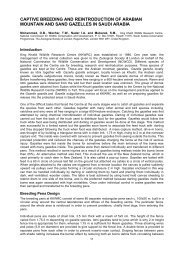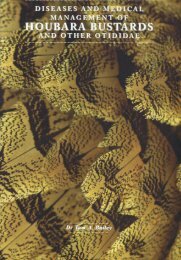His Highness Sheikh Zayed bin Sultan Al Nahyan - Wildlife Middle ...
His Highness Sheikh Zayed bin Sultan Al Nahyan - Wildlife Middle ...
His Highness Sheikh Zayed bin Sultan Al Nahyan - Wildlife Middle ...
You also want an ePaper? Increase the reach of your titles
YUMPU automatically turns print PDFs into web optimized ePapers that Google loves.
the book indispensable when interpreting normal and<br />
abnormal blood films. In the tables of normal haematology<br />
values (Tables 2.4 to 2.11) it would have been useful to have<br />
conducted appropriate statistics according to the<br />
distribution of the data (parametric or non-parametric) and<br />
to have included the range and a 95% confidence interval.<br />
I have no experience with automated haematology<br />
systems with falcons, but consider that these systems tend to<br />
overestimate the white cell count compared to manual<br />
methods. The haematology values presented in Tables 2.4<br />
to 2.11, derived from the Cell Dyn 3500 analyser would<br />
appear to be 20-30% higher than values calculated using<br />
manual methods that are reported in the literature (Samour<br />
et al, 1996) or that are used in-house in our hospital. In the<br />
preface the authors have highlighted the need for the<br />
laboratory equipment industry to develop new technologies<br />
that can be applied to falcons and the wider field of avian<br />
medicine. This is clearly important and studies correlating<br />
manual with automated haematology results are also<br />
warranted. Like any book there will always be some areas<br />
where one has an alternative view to the authors, but these<br />
comments are minor areas that do not detract from the<br />
overall value of the book. For example, in the section on<br />
falcon leukogrammes the authors consider white cell counts<br />
above 15-17,000 are rarely exhibited in infectious diseases.<br />
In our hospital we commonly see leukogrammes in excess<br />
of 20,000, particularly in aspergillosis cases. That said I<br />
congratulate the authors for presenting their data. Tens of<br />
thousands of haematology samples have been processed at<br />
falcon hospitals throughout the <strong>Middle</strong> East over the last<br />
two decades, and it is surprising that with the exception of<br />
Samour et al (1996), not one hospital has published their<br />
data (and I am guilty too). It is amazing how much more<br />
basic research is needed in this field.<br />
The section on biochemistry could be improved in<br />
future editions. The authors state that EDTA samples were<br />
used to derive the chemistry parameters. Chemical artefacts<br />
are reported to occur in such samples, particularly<br />
phosphorus and calcium (Hochleithner, 1994; Fudge, 1997;<br />
2000). I could not find a legend explaining whether the<br />
parameter ranges given in Table 2.18 are ranges (maximum<br />
- minimum) or confidence intervals, I assume they are<br />
ranges. Statistical interpretation of the data would have<br />
been helpful in establishing reference intervals for the<br />
biochemistry results in Table 2.17. The use of mean and<br />
standard deviation is not appropriate for data that has a nonparametric<br />
distribution. Many recent publications<br />
presenting reference values for avian species assess whether<br />
the data for each parameter is parametrically or nonparametrically<br />
distributed and then conduct appropriate<br />
statistical tests to determine confidence intervals (Lumeij,<br />
1987; 1993; Lierz, 2003). Likewise, as a clinician I have a<br />
tendency to be cautious of laboratory-derived normal values<br />
because laboratories can only base their assessment of<br />
normality from the clinicians specimen report. Many is the<br />
time an apparently clinically ‘normal’ bird that was blood<br />
sampled for a routine health check on one day, is diagnosed<br />
with a serious condition a day or so later.<br />
Chapter 3, Viral diseases, is highly informative and<br />
very well laid out. Again the haematology pictures<br />
com<strong>bin</strong>ed with the tables of haematology/chemistry results<br />
from falcons will be helpful to clinicians in the diagnostic<br />
front line. The sequence of images on various viral diseases<br />
in prey species (houbara, stone curlew, etc) provide the reader<br />
with an insight into why these diseases are so important in<br />
falcons in the <strong>Middle</strong> East. The gross pathology images<br />
throughout the viral, bacterial and parasitic disease chapters<br />
are excellent and will be very helpful for anyone having to<br />
conduct post-mortem examinations. Likewise, I am sure the<br />
histopathology images will be helpful to pathologists. The<br />
section on parasitic diseases will be a very handy reference to<br />
have next to your microscope because the haemoparasites<br />
and other parasites of falcons have not been as well illustrated<br />
in the other raptor texts. Future editions of this book could<br />
consider including a series of cytology images. In addition<br />
more clinical images, including radiographs and gross lesions<br />
in the disease sections, particularly bacterial diseases, would<br />
be helpful for veterinarians making clinical interpretation in<br />
a hospital setting.<br />
The book might have been better termed A Colour<br />
Atlas of Haematology and Diseases of Falcons, because the<br />
emphasis on medicine is limited. That said Colour Atlas of<br />
Falcon Medicine is a worthy addition to the raptor and avian<br />
literature. Its greatest value is the profuse use of high quality<br />
images and this is a book that will certainly complement<br />
other more medically orientated texts on raptor medicine<br />
such as Birds of Prey Medicine and Management by Manfred<br />
Heidenreich or Birds of Prey Health and Disease by John<br />
Cooper. I congratulate the authors for this impressive atlas<br />
that shares their knowledge and experience gained over<br />
decades of work with raptors and laboratory medicine in the<br />
<strong>Middle</strong> East. To anyone with an interest in raptor health and<br />
management, this is an essential purchase for your bookshelf.<br />
References<br />
Fudge, A. 1997. Avian clinical pathology: haematology and<br />
biochemistry. In: <strong>Al</strong>tman, R.B., Club, S.L.,<br />
Dorrestein, G.M. and Quesenbury, K (eds), Avian<br />
Medicine and Surgery. WB Saunders Co.,<br />
Philadelphia, USA. Pp 142-157.<br />
Fudge, A.M. (ed.) 2000. Laboratory Medicine. W.B.<br />
Saunders Company, Philadelphia, Pennsylvania. Pp<br />
19-27.<br />
Hochleithner, M. 1995. Biochemistries. In: Ritchie, B.W.,<br />
Harrison, G.J. and Harrison, L.R. (eds), Avian<br />
Medicine and Surgery: principles and applications.<br />
Wingers Publishing Inc, Lake Worth, Florida. Pp<br />
223-245.<br />
Leirz, M. 2003. Plasma chemistry reference values for<br />
gyrfalcons (Falco rusticolus). Veterinary Record.<br />
153: 182-183.<br />
Lumeij, J.T. 1987. A contribution to clinical investigative<br />
methods for birds, with special reference to the<br />
racing pigeon, Columba livia domestica. PhD<br />
Thesis, University of Utrecht, Netherlands.<br />
Lumeij, J.T. 1993. Avian plasma chemistry in health and<br />
disease. Proceedings of the Annual Conference of<br />
the Association of Avian Veterinarians, Nashville,<br />
TN. Pp 20-26.<br />
Samour, J., D’<strong>Al</strong>oia, M.-A. and Howlett, J.C. 1996. Normal<br />
haematology of captive saker falcons (Falco<br />
cherrug). Comparative Haematology International.<br />
6: 50-52.<br />
22




